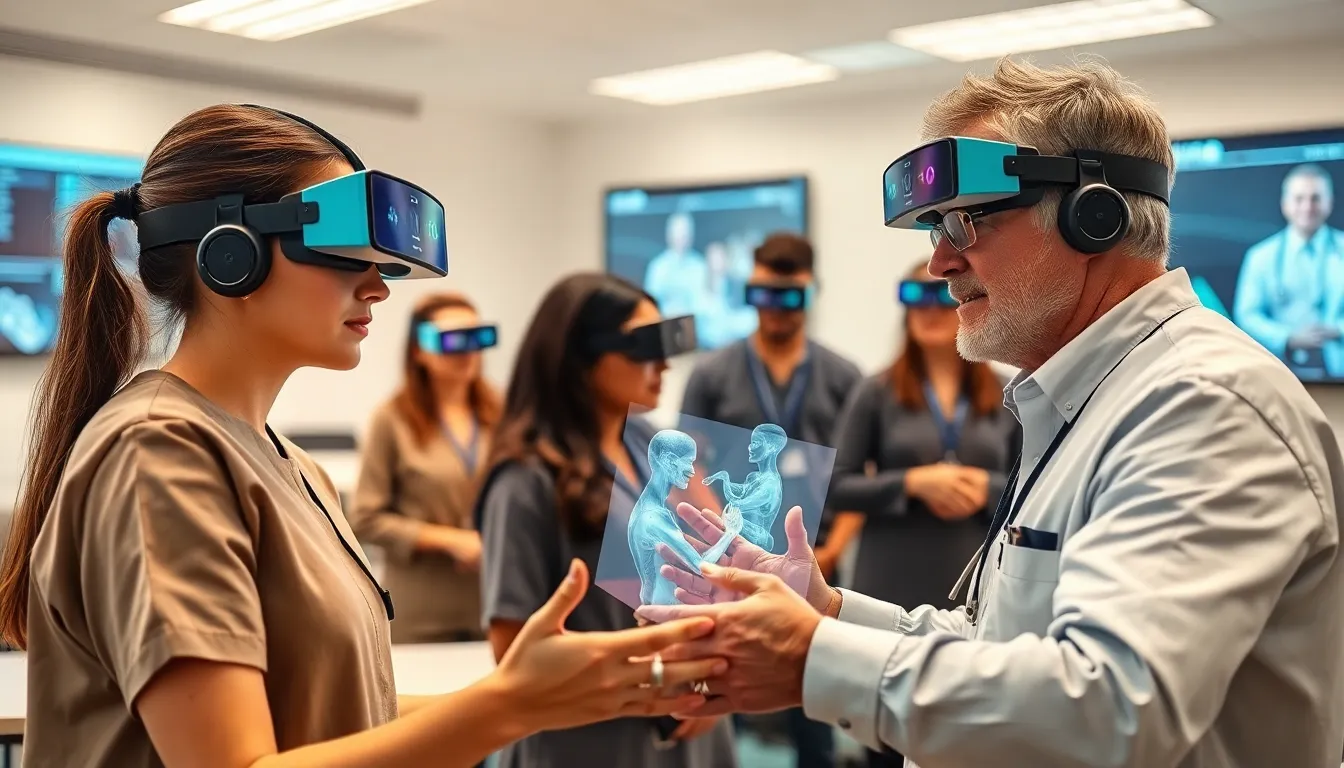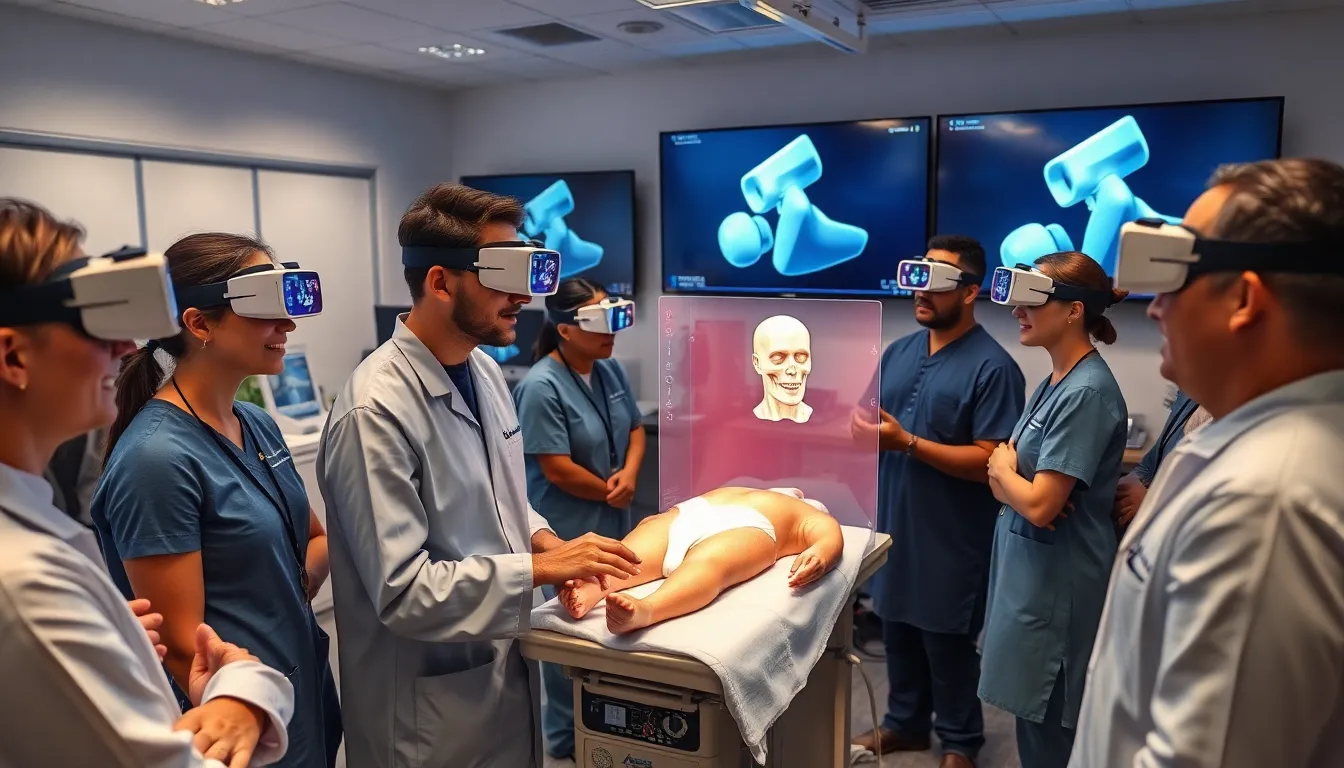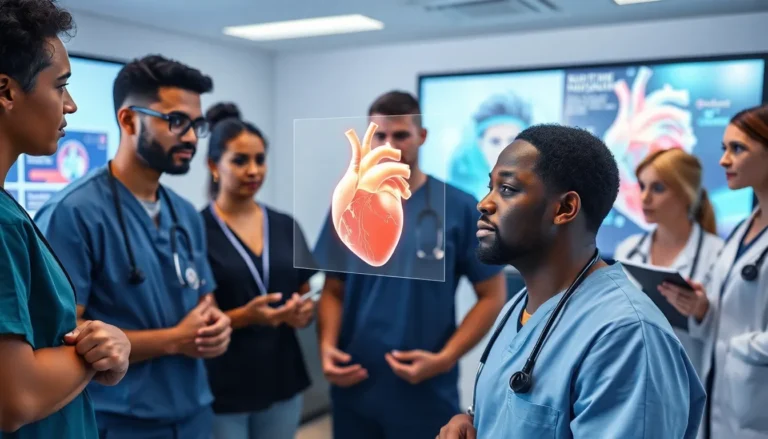Table of Contents
ToggleImagine stepping into a training session where you don’t just read about safety protocols but actually see them in action—complete with virtual fire-breathing dragons and high-fiving robots. Welcome to the world of augmented reality (AR) for training, where learning gets a high-tech makeover that’s as engaging as it is effective.
In a landscape where traditional training methods can feel as exciting as watching paint dry, AR breathes new life into skill acquisition. It transforms mundane lessons into immersive experiences, making employees not just participants but active learners. With AR, training isn’t just about the transfer of knowledge; it’s about creating unforgettable experiences that stick. So why settle for boring when you can train with flair?
Overview of Augmented Reality for Training
Augmented reality (AR) significantly enhances training by blending digital content with the real world. This technology fosters immersive learning experiences through interactive simulations and visuals. Employees engage more effectively with training materials, leading to better retention of information.
Benefits of AR in training are numerous. Enhanced engagement through gamified elements keeps learners invested in their education. Immediate feedback during training sessions facilitates quicker skill acquisition and confidence building. Cohesive and memorable experiences boost long-term knowledge retention among employees.
Various industries adopt AR for training purposes. Medical professionals use AR to practice complex procedures in a risk-free environment. Manufacturing companies utilize AR to train workers on intricate machinery, minimizing downtime. Retail businesses implement AR simulations to improve customer service skills among staff.
Implementing AR in training requires careful planning. Organizations should analyze training objectives to create relevant AR content. Integrating AR with existing training modules streamlines processes and maximizes training efficacy. Adequate technological infrastructure ensures a seamless delivery of AR experiences.
The future of training appears promising with AR. Emerging technologies like artificial intelligence will enhance AR experiences further. Enhanced personalization allows tailored learning paths for employees of varying skill levels. Overall, AR transforms how organizations approach training, providing engaging and effective learning environments.
Benefits of Augmented Reality in Training


Augmented reality (AR) revolutionizes the way training is delivered. This technology enhances traditional learning experiences, offering a blend of digital content and the real world.
Enhanced Learning Experience
Interactive simulations create an immersive atmosphere where trainees can practice skills in realistic scenarios. Medical professionals, for instance, can simulate surgeries, which boosts their confidence. Users engage with three-dimensional visuals that make complex concepts easier to grasp. Facilitators customize modules to fit learners’ needs, ensuring tailored experiences. Such personalization increases the relevance of training content, enhancing understanding and application.
Increased Engagement and Retention
AR captivates users, making learning more enjoyable and effective. Gamified elements encourage participation, which leads to higher retention rates. Immediate feedback keeps learners informed about their progress, reinforcing skills. Users often remember training activities longer when they are interactive. Various studies indicate that people retain about 75% of information learned through experiential activities compared to only 10% from traditional lectures. Engaging training methods lead to greater material recall and application in real-world situations.
Applications of Augmented Reality for Training
Augmented reality transforms training across various sectors, offering unique applications that enhance learning experiences.
Corporate Training
In corporate settings, AR boosts employee engagement and participation. Companies utilize AR for onboarding processes, creating interactive environments that allow new hires to explore company culture and policies. Role-playing scenarios simulate real-life customer interactions, improving sales skills and customer service techniques. Immediate feedback enhances performance, and tracking progress ensures objectives align with training goals. Enhanced retention occurs, as employees grasp complex concepts through engaging visuals and interactive tasks.
Medical Training
Medical professionals benefit significantly from AR, which provides safe, realistic training environments. Surgeons practice intricate procedures, observing anatomical structures and surgical techniques through 3D visuals. Emergency responders can train for crisis scenarios without the risks of real-life situations. Patient simulations prepare staff for accurate diagnostics and effective communication. The immersive nature of AR ensures long-lasting knowledge retention and sharpens decision-making skills, ultimately leading to improved patient outcomes.
Technical Skills Development
Industries focused on technical skills, such as manufacturing and construction, incorporate AR for hands-on training. Workers learn to operate machinery through virtual overlays that guide them step-by-step. This visual assistance reduces the chance of errors and builds confidence in handling complex tasks. Equipment maintenance training uses AR to provide real-time troubleshooting and instructions. Increased proficiency and faster learning cycles result from these interactive experiences, enabling workers to adapt to new technologies and processes efficiently.
Challenges and Limitations
Augmented reality (AR) presents several challenges and limitations for training, despite its transformative potential. Addressing these obstacles is essential for effective implementation.
Technical Barriers
Technical barriers significantly impact the adoption of AR in training environments. Inadequate software can hinder the seamless integration of AR applications. Some organizations lack the necessary hardware, such as mobile devices or AR glasses, for optimal experiences. Issues with internet connectivity can disrupt training sessions, leading to frustration. Additionally, technical support might fall short, leaving users struggling to troubleshoot problems during critical training moments. Ensuring compatibility across different devices also presents challenges that require careful consideration.
Cost Considerations
Cost considerations play a critical role in the adoption of AR for training purposes. Initial investments in AR technology can be substantial, encompassing software development, hardware procurement, and maintenance. Organizations must allocate funding for specialized staff to create and manage AR content. Budget limitations often impact the extent of implementation, resulting in scaled-back initiatives. Long-term financial implications, including updates and upgrades, create additional burdens for organizations. Balancing the potential return on investment with upfront costs remains a pivotal factor for decision-makers.
Future Trends in Augmented Reality for Training
Emerging technologies are shaping the future of augmented reality in training environments. Artificial intelligence enhances AR experiences, allowing for personalized learning paths that cater to individual skill levels. Organizations adopt adaptive learning frameworks, which adjust content in real-time based on user progress and engagement.
Industry leaders recognize the importance of data analytics in augmenting training effectiveness. These analytics provide crucial insights into user behavior and performance, enabling organizations to refine training sessions continuously. Increased integration of mixed reality tools is likely, combining elements of AR and virtual reality for even more immersive experiences.
Collaboration tools will become pivotal in AR training. Participants can connect with remote experts during training sessions, broadening access to knowledge and expertise. Accessibility features are also evolving, ensuring that AR training becomes inclusive and available to a wider audience.
Microlearning strategies will complement AR training modules. Short, focused learning segments allow for better retention, enhancing the overall training experience. Gamification will continue evolving, integrating competitive aspects to motivate learners and drive engagement.
Investment in augmented reality technology is predicted to expand. Companies prioritize maximizing returns by implementing cost-effective AR solutions, thereby reducing barriers to entry. As more case studies demonstrate AR’s effectiveness, adoption rates across various industries are expected to rise.
Collaborative partnerships between tech companies and educational institutions will foster innovative training models. These partnerships will lead to the development of new tools and techniques, further enriching the AR training landscape. Ultimately, augmented reality is set to redefine training, providing immersive, interactive experiences that adapt to the needs of learners.
Augmented reality is reshaping the landscape of training by making it more engaging and effective. Its ability to create immersive experiences allows learners to practice skills in realistic scenarios without the associated risks. As industries continue to adopt AR, the focus on interactive and gamified training methods will likely grow.
While challenges such as technical barriers and cost considerations exist, the potential benefits of AR in enhancing knowledge retention and skill acquisition are undeniable. As technology advances and organizations invest in AR solutions, the future of training looks bright. By embracing this innovative approach, companies can foster an environment where learning is not only effective but also enjoyable, ultimately leading to a more skilled and confident workforce.







